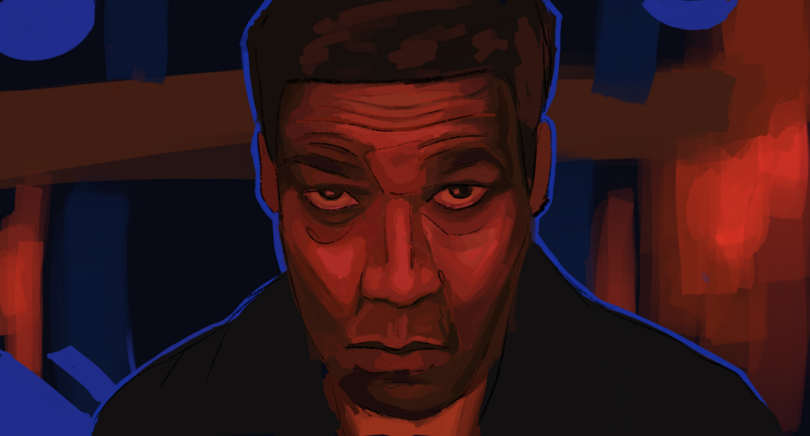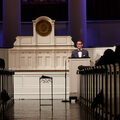Spike Lee’s identity, formative influences ever-present in ‘Highest 2 Lowest’

Denzel Washington shines in "Highest 2 Lowest," our columnist says. In his fifth collaboration with Spike Lee, Washington uses his eyes, especially in tight shots, to share deep emotions from his character. Sophia Berger | Contributing Illustrator
Get the latest Syracuse news delivered right to your inbox.
Subscribe to our newsletter here.
A clean beat, smooth bassline, dope sample and recognizable voice is a winning formula for a classic hip-hop song.
Likewise, Denzel Washington, James Brown tracks, inspiration from Akira Kurosawa and Spike Lee’s creative genius is a winning formula for creating the slick, melodic film, “Highest 2 Lowest.”
Set in Lee’s cherished New York City, “Highest 2 Lowest” follows music producer David King (Washington) as he becomes the victim of a ransom plot. Based on Kurosawa’s legendary “High and Low,” the new Spike Lee joint recycles Kurosawa’s framework while producing a fresh, modernized look at family, legacy and obsession.
Proclaimed as “the best ears in the business,” David wants to regain majority ownership of the record label he founded, Stackin’ Hits Records. He plans to buy an associate’s shares to shut out a competing label, Stray Dog Records (likely a nod to Kurosawa’s 1949 film).
After returning home from discussing the deal, an anonymous kidnapper calls David, demanding $17.5 million in exchange for his son, Trey King (Aubrey Joseph). Paralleling “High and Low,” it’s revealed that the kidnapper accidentally took Kyle Christopher (Elijah Wright), the son of David’s friend and chauffeur, Paul Christopher (Jeffrey Wright).
David was going to pay the ransom for Trey’s life — no questions asked. But it takes convincing from his family and Paul before eventually paying to get Kyle back so they can get a lead on the criminal.
Despite being an adaptation, “Highest 2 Lowest” oozes style and personality. Instead of mimicking Kurosawa, who’s donned as “The Master Filmmaker” in the closing credits, Lee’s first collaboration with A24 feels uniquely him.
Set largely in the Bronx and Brooklyn, Lee’s home after moving from Atlanta as a child, the Empire City feels like its own character in the narrative (even more than Yokohama, Japan, in “High and Low”).
In the middle of the film, an elaborate chase sequence starts in the depths of the subway — filled with Yankees fans shouting, “Boston sucks!” — and transitions to the lively National Puerto Rican Day Parade. The scene is packed with NYC novelties, but they don’t impede its fluidity. When David first enters the subway, Lee begins using Super 8 and 16mm film intermittently, wrapping the screen in a warm, nostalgic texture. This is when “Highest 2 Lowest” really takes off and embraces originality.
My favorite scene is when David and Paul search for the kidnapper. A jump cut shows a glaring David, accompanied by a fitting musical needle drop of “The Boss.” David rips off his jacket and tie and asks Paul for a pistol. Simultaneously, the Godfather of Soul (Brown) sings, “I paid the cost to be the boss . . . You know what you see? You see a bad mother.” The moment is drenched in pure swagger.
While the movie might not be as clever as Kurosawa’s perfect film noir, Lee makes up for it thematically.
In “Highest 2 Lowest,” the father-son relationship is touched on in greater depth than in its parent film. During one scene, a distressed David questions his ability to be a good father.
After a heated conversation with Trey regarding paying the ransom, David goes to his office. He asks portraits of his heroes, like Stevie Wonder, Jimi Hendrix and Aretha Franklin, how they’d handle the situation. Directing his voice toward a photo of his Time Magazine cover and a photo of Trey, he says, “What do I tell him? Y’all talk to each other, ‘cause I can’t talk to him.”
Washington never skips a beat, delivering a magnetic performance in his fifth collaboration with Lee. His eyes display strong emotions, which are enhanced by tight shots and dolly zooms.
Outside of Washington and Wright, the most noteworthy performance is A$AP Rocky, who’s revealed as the kidnapper and rapper, Yung Felon. Rocky holds his own in the presence of the Academy Award-winning Washington.
Felon is obsessed with David, even naming his son after him; he dreams of David recognizing his music. A standout scene is a rap battle between the two in a recording studio, highlighting the film’s subtle humor during intense moments.
Rocky’s newest single, “Trunks,” serves as Chekhov’s gun in the movie, eventually helping David and Paul track down the kidnapper. I’d be surprised if you don’t come away from “Highest 2 Lowest” with this bop — or a classic funk track — stuck in your head.
From its debut at the Cannes Film Festival in May to a limited theatrical run beginning mid-August, “Highest 2 Lowest” has received mixed reviews. Earning a strong 87% critic score and 85% audience score from Rotten Tomatoes, the picture mustered a 5.8 from IMDb.
Complaints include an overly long exposition, an inconsistent script and an incompatible score. At times, I felt bored with the first half — likely because I had high expectations having watched “High and Low” the day before — but if anything, its methodical pace ramps up the excitement of the second half. As for Howard Drossin’s score, I agree it does feel conflicting, not fully jiving with the scenes they match. The music can stand alone, but it seems corny when the stakes are so high.
However, most of the criticism is hyperbolic; nobody can match Kurosawa.
Reflective of Spike Lee’s own production company, the film concludes with David deciding to start a family record label, permitting creative freedom and proper distribution of Black art.
Lee hasn’t had success with remakes (“Da Sweet Blood of Jesus” and “Oldboy”), but this Apple TV+ exclusive is a grand exception. Whether you’re a fan of Lee, Kurosawa, Washington, the Yankees or music, “Highest 2 Lowest” has something for everyone to enjoy.






